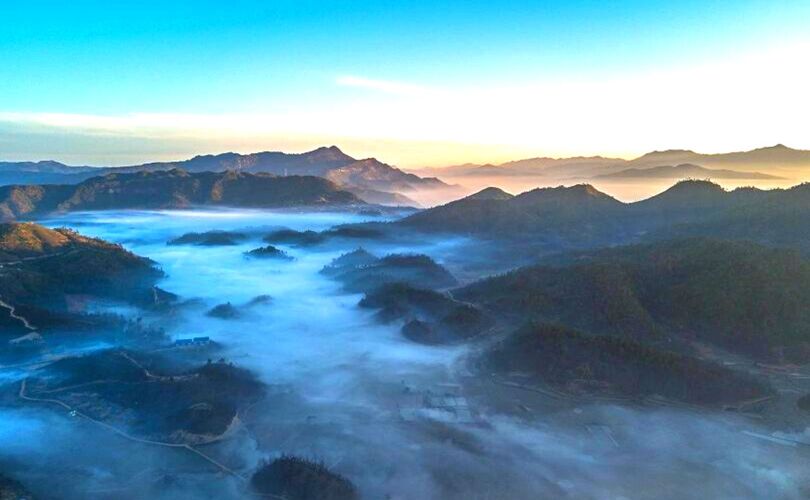Phawngpui National Park
Phawngpui National Park In Mizoram, India
Phawngpui National Park, also known as Phawngpui Blue Mountain National Park, is a mesmerizing natural wonder located in the northeastern state of Mizoram, India. It is named after Phawngpui Peak, the highest mountain in Mizoram, which stands at an impressive elevation of approximately 2,157 meters above sea level. The park is spread over a large area and is a significant part of Mizoram’s ecological and cultural heritage.
The name “Phawngpui” itself is derived from Mizo folklore, where it is often referred to as the abode of the gods. The mountain and its surroundings are deeply revered by the local Mizo people, and many myths and legends are associated with the region, adding a mystical charm to its already captivating landscape. Phawngpui National Park is characterized by its stunning natural beauty, with rolling hills, deep valleys, and the enchanting blue haze that often surrounds the mountains, giving it a surreal and almost dreamlike appearance.
The park is covered with dense forests, lush green meadows, and a wide variety of flora, making it a biodiversity hotspot in the region. One of the most remarkable features of the park is its rich collection of rhododendrons, which bloom in vibrant shades of red, pink, and white, transforming the landscape into a colorful paradise.
Along with rhododendrons, the park is also home to numerous species of orchids and medicinal plants, which further enhance its ecological significance. The park is a haven for wildlife enthusiasts, as it shelters a diverse range of animal species, including several rare and endangered ones. Among the most notable inhabitants of Phawngpui National Park is the elusive clouded leopard, a majestic and endangered big cat that finds refuge in the dense forests.
Other prominent mammals found in the park include the Asiatic black bear, leopard cat, Himalayan serow, goral, and barking deer. The park’s wildlife is not just limited to mammals; it is also a paradise for birdwatchers, as it is home to numerous exotic bird species. The vibrant and rare Mrs. Hume’s pheasant, Blyth’s tragopan, different species of hornbills, and various colorful partridges are some of the birds that can be spotted in the park.
Their presence adds a melodious charm to the already tranquil and serene environment. Phawngpui National Park is not just a treasure trove of flora and fauna but also an ideal destination for adventure seekers and trekkers. The park offers several trekking routes that lead visitors through its scenic trails, thick forests, and breathtaking viewpoints. Trekking to the summit of Phawngpui Peak is a thrilling experience, as it provides panoramic views of the surrounding valleys and distant hills.
On a clear day, one can even catch a glimpse of the neighboring country of Myanmar from the peak. The trek is moderately challenging, making it suitable for both amateur and experienced trekkers. Along the way, trekkers can witness the unspoiled beauty of nature, encounter rare plant species, and observe wildlife in their natural habitat. Apart from its ecological and adventurous appeal, Phawngpui National Park also holds cultural and spiritual significance for the Mizo people.
Many local legends and folktales revolve around the Blue Mountain, and it is considered a sacred place. According to Mizo mythology, Phawngpui was believed to be the dwelling place of the goddess “Sangau,” and the area was once thought to be inhabited by spirits and supernatural beings. Even today, the mountain and the park are treated with great reverence, and visitors are expected to respect the local customs and traditions while exploring the region.
The trek from Sangau to the summit is an unforgettable experience, filled with breathtaking views, exotic wildlife encounters, and a sense of adventure. Phawngpui National Park remains one of India’s most pristine and less-explored national parks, making it a perfect destination for nature lovers, wildlife enthusiasts, and adventure seekers looking to escape the hustle and bustle of city life.
With its untouched wilderness, rich biodiversity, and spiritual significance, the park offers a unique and unforgettable experience to those who venture into its serene landscapes. Whether it is the mesmerizing views from the summit, the thrill of spotting a rare clouded leopard, or the joy of witnessing colorful rhododendrons in full bloom, Phawngpui National Park is a hidden gem waiting to be explored.
How To Reach
Safari Timing
Best Time To Visit
Winter (November to February):- Flora & Fauna – Rhododendrons bloom, and wildlife like goral and serow are active. Birdwatching – Ideal time to spot rare birds like the Blyth’s tragopan.
Copyright © 2025 National Park in India. All Rights Reserved



